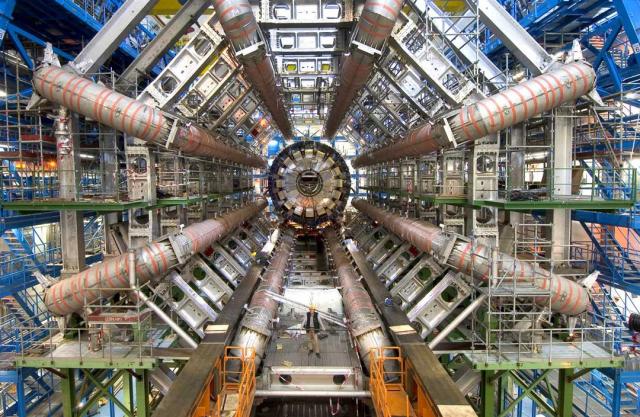Scientists at CERN have observed quantum entanglement at energies higher than ever before, marking a significant milestone in particle physics. This groundbreaking discovery at the Large Hadron Collider (LHC) opens new avenues for understanding the quantum realm.
The world of quantum physics is a realm of wonder and mystery, where particles can exist in multiple states simultaneously and influence each other instantaneously across vast distances. One of the most fascinating phenomena in this domain is quantum entanglement, a condition where particles become linked and the state of one instantly influences the state of another, no matter how far apart they are. Recently, scientists at CERN’s Large Hadron Collider (LHC) have made a groundbreaking observation of quantum entanglement at the highest energies ever recorded, pushing the boundaries of our understanding even further.
The Significance of Quantum Entanglement
Quantum entanglement is not just a theoretical curiosity; it has practical implications for fields like quantum computing, cryptography, and teleportation. Entanglement challenges our classical understanding of physics, suggesting that particles can be interconnected in ways that Einstein famously referred to as “spooky action at a distance.” This phenomenon has been observed and tested extensively at low energies, but observing it at higher energies is crucial for validating quantum mechanics in extreme conditions.
CERN’s Landmark Observation
According to a press release from CERN, the LHC experiments ATLAS, CMS, and LHCb have, for the first time, observed pairs of W or Z bosons produced via photon collisions. These heavy force-carrying particles mediate the weak nuclear force and are integral to the Standard Model of particle physics. The observation was made possible by exploiting the LHC’s ability to accelerate particles to near light speeds, increasing the energy levels at which interactions occur.
Why This Matters
Observing quantum entanglement at such high energies serves multiple purposes. Firstly, it tests the limits of the Standard Model, potentially revealing areas where new physics might emerge. Secondly, it provides empirical data that can validate or challenge existing theories about particle interactions at high energies. Lastly, it opens up new experimental possibilities, such as studying the behavior of other particles under similar conditions.
The Mechanics Behind the Discovery
In the LHC, protons are accelerated to extremely high speeds and collided to observe the resulting particle interactions. However, in this case, the focus was on photon-photon collisions. Photons are particles of light that can sometimes produce heavier particles when they collide under high-energy conditions. The experiments observed pairs of W or Z bosons resulting from these photon collisions, an event that had not been seen before at such energies.
Photon-Photon Collisions: A Closer Look
Photon-photon collisions are rare and require precise conditions to observe. Unlike proton-proton collisions, photon collisions are less likely to produce a messy array of particles, making it easier to study specific interactions. The successful observation of W and Z boson pairs indicates that photons can interact at high energies to produce heavy particles, a phenomenon predicted by quantum electrodynamics but not previously observed at this scale.
The Standard Model is the prevailing theory in particle physics that describes the fundamental particles and their interactions. While it has been remarkably successful, it is known to be incomplete. Observations like this test the model’s predictions and can highlight discrepancies that might point to new physics. The successful observation of high-energy entanglement supports the Standard Model’s predictions but also sets the stage for exploring phenomena beyond its scope.
This discovery is not an endpoint but a gateway to further research. Scientists are now interested in exploring whether similar entanglements can be observed with other particles or under different conditions. The LHC is scheduled for upgrades that will increase its luminosity, allowing for even more precise measurements and potentially new discoveries.
Such a monumental achievement is the result of international collaboration involving thousands of scientists and engineers. The ATLAS, CMS, and LHCb experiments are massive undertakings that require expertise from around the world. This collective effort underscores the importance of global cooperation in advancing scientific knowledge.
Public Engagement and Education
Discoveries like this capture the public’s imagination and inspire the next generation of scientists. By making complex topics accessible, institutions like CERN help demystify science and encourage curiosity. Educational outreach programs and transparent communication are vital for maintaining public interest and support for fundamental research.
Challenges and Limitations
While the observation is a significant milestone, it also presents challenges. High-energy experiments are costly and require sophisticated equipment and safety protocols. Additionally, interpreting the data requires complex theoretical frameworks and computational resources. Balancing these challenges with the potential for groundbreaking discoveries is an ongoing task for the scientific community.
The observation of quantum entanglement at the highest energies yet achieved marks a pivotal moment in particle physics. It not only validates aspects of quantum mechanics and the Standard Model but also opens up new pathways for research. As we continue to probe the fundamental laws of the universe, such discoveries bring us one step closer to unraveling the deepest mysteries of reality.
Further Reading
For those interested in delving deeper into this topic, the original CERN press release provides a detailed account of the experiments and their significance. Additional resources include publications from the ATLAS, CMS, and LHCb collaborations, which offer technical insights into the methodologies and implications of their findings.




